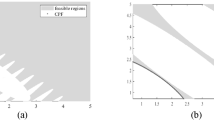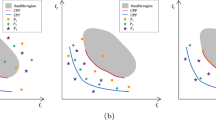Abstract
When solving constrained multiobjective optimization problems (CMOPs), it is important to uniformly explore the promising regions that are not dominated by feasible solutions, and this can effectively avoid the loss of the Pareto front fragments. To achieve this, we propose a grid-based uniform search (GUS) to guide the current population to search the promising areas uniformly in this paper. Therein, the promising areas are divided into a number of grids, which are then fully explored by the individuals located in them. In the process of reducing the population size, the individuals with the largest constraint violations in the most crowded grids are removed one by one. To balance the local search and the global search, we dynamically reduce the number of divided grids in GUS with the increase of evolutionary iterations. Embedding the dynamic GUS in evolutionary algorithm, we design a new constrained algorithms for CMOPs. Experimental results show that the proposed algorithm performs better than other state-of-the-art constrained evolutionary multiobjective optimization algorithms in dealing with different CMOPs.





Similar content being viewed by others
Explore related subjects
Discover the latest articles, news and stories from top researchers in related subjects.References
Asafuddoula M, Ray T, Sarker R (2014) A decomposition-based evolutionary algorithm for many objective optimization. IEEE Trans Evol Comput 19(3):445–460
Bai L, Lin W, Gupta A, Ong YS (2021) From multitask gradient descent to gradient-free evolutionary multitasking: a proof of faster convergence. IEEE Trans Cybern 1–13
Bosman PA, Thierens D (2003) The balance between proximity and diversity in multiobjective evolutionary algorithms. IEEE Trans Evol Comput 7(2):174–188
Chen X, Hou Z, Liu J (2008) Multi-objective optimization with modified pareto differential evolution. In: 2008 International conference on intelligent computation technology and automation (ICICTA), vol 1. IEEE, pp 90–95
Cheng J, Yen GG, Zhang G (2016) A grid-based adaptive multi-objective differential evolution algorithm. Inf Sci 367:890–908
Cheng R, Jin Y, Olhofer M, Sendhoff B (2016) A reference vector guided evolutionary algorithm for many-objective optimization. IEEE Trans Evol Comput 20(5):773–791
Chiandussi G, Codegone M, Ferrero S, Varesio FE (2012) Comparison of multi-objective optimization methodologies for engineering applications. Comput Math Appl 63(5):912–942
Das I, Dennis JE (1998) Normal-boundary intersection: a new method for generating the Pareto surface in nonlinear multicriteria optimization problems. SIAM J Optim 8(3):631–657
Deb K, Agrawal RB (1995) Simulated binary crossover for continuous search space. Complex Syst 9(2):115–148
Deb K, Goyal M (1996) A combined genetic adaptive search (GeneAS) for engineering design. Comput Sci Inform 26:30–45
Deb K, Pratap A, Meyarivan T (2001) Constrained test problems for multi-objective evolutionary optimization. In: International conference on evolutionary multi-criterion optimization. Springer, pp 284–298
Fan Z, Fang Y, Li W, Cai X, Wei C, Goodman E (2019) MOEA/D with angle-based constrained dominance principle for constrained multi-objective optimization problems. Appl Soft Comput 74:621–633
Fan Z, Li W, Cai X, Li H, Wei C, Zhang Q, Deb K, Goodman E (2019) Difficulty adjustable and scalable constrained multi-objective test problem toolkit. Evol Comput 1–28
Fan Z, Li W, Cai X, Li H, Wei C, Zhang Q, Deb K, Goodman E (2019) Push and pull search for solving constrained multi-objective optimization problems. Swarm Evol Comput 44:665–679
Fan Z, Wang Z, Li W, Yuan Y, You Y, Yang Z, Sun F, Ruan J (2020) Push and pull search embedded in an M2M framework for solving constrained multi-objective optimization problems. Swarm Evol Comput 54:100651
Guo Y, Yang H, Chen M, Gong D, Cheng S (2020) Grid-based dynamic robust multi-objective brain storm optimization algorithm. Soft Comput 24(10):7395–7415
Han L, Wang H (2021) A random forest assisted evolutionary algorithm using competitive neighborhood search for expensive constrained combinatorial optimization. Memet Comput 13(1):19–30. https://doi.org/10.1007/s12293-021-00326-9
Jain H, Deb K (2013) An evolutionary many-objective optimization algorithm using reference-point based nondominated sorting approach, part II: handling constraints and extending to an adaptive approach. IEEE Trans Evol Comput 18(4):602–622
Jan MA, Khanum RA (2013) A study of two penalty-parameterless constraint handling techniques in the framework of MOEA/D. Appl Soft Comput 13(1):128–148
Jan MA, Tairan N, Khanum RA (2013) Threshold based dynamic and adaptive penalty functions for constrained multiobjective optimization. In: 2013 1st international conference on artificial intelligence. Modelling and Simulation. IEEE, pp 49–54
Jiao L, Li L, Shang R, Liu F, Stolkin R (2013) A novel selection evolutionary strategy for constrained optimization. Inf Sci 239:122–141
Jiao L, Luo J, Shang R, Liu F (2014) A modified objective function method with feasible-guiding strategy to solve constrained multi-objective optimization problems. Appl Soft Comput 14:363–380
Lara A, Uribe L, Alvarado S, Sosa VA, Wang H, Schütze O (2019) On the choice of neighborhood sampling to build effective search operators for constrained mops. Memet Comput 11(2):155–173
Li H, Ma J, Gong M, Jiang Q, Jiao L (2015) Change detection in synthetic aperture radar images based on evolutionary multiobjective optimization with ensemble learning. Memet Comput 7(4):275–289
Li K, Deb K, Zhang Q, Kwong S (2014) An evolutionary many-objective optimization algorithm based on dominance and decomposition. IEEE Trans Evol Comput 19(5):694–716
Li K, Chen R, Fu G, Yao X (2018) Two-archive evolutionary algorithm for constrained multiobjective optimization. IEEE Trans Evol Comput 23(2):303–315
Liu ZZ, Wang Y, Huang PQ (2020) AnD: a many-objective evolutionary algorithm with angle-based selection and shift-based density estimation. Inf Sci 509:400–419
Ma Z, Wang Y (2019) Evolutionary constrained multiobjective optimization: test suite construction and performance comparisons. IEEE Trans Evol Comput 23(6):972–986. https://doi.org/10.1109/TEVC.2019.2896967
Martinez SZ, Coello CAC (2014) A multi-objective evolutionary algorithm based on decomposition for constrained multi-objective optimization. In: 2014 IEEE congress on evolutionary computation (CEC). IEEE, pp 429–436
Panda A, Pani S (2016) A symbiotic organisms search algorithm with adaptive penalty function to solve multi-objective constrained optimization problems. Appl Soft Comput 46:344–360
Peng C, Liu HL, Goodman ED (2020) Handling multi-objective optimization problems with unbalanced constraints and their effects on evolutionary algorithm performance. Swarm Evol Comput 100676
Qian F, Xu B, Qi R, Tianfield H (2012) Self-adaptive differential evolution algorithm with \(\alpha \)-constrained-domination principle for constrained multi-objective optimization. Soft Comput 16(8):1353–1372
Sinha A, Malo P, Deb K (2018) A review on bilevel optimization: from classical to evolutionary approaches and applications. IEEE Trans Evol Comput 22(2):276–295
Wang WL, Li WK, Wang Z, Li L (2019) Opposition-based multi-objective whale optimization algorithm with global grid ranking. Neurocomputing 341:41–59
Yang S, Li M, Liu X, Zheng J (2013) A grid-based evolutionary algorithm for many-objective optimization. IEEE Trans Evol Comput 17(5):721–736
Yang Y, Liu J, Tan S (2020) A constrained multi-objective evolutionary algorithm based on decomposition and dynamic constraint-handling mechanism. Appl Soft Comput 89. https://doi.org/10.1016/j.asoc.2020.106104
Yuan J (2021) A constraint handling technique using compound distance for solving constrained multi-objective optimization problems. AIMS Math 6(6):6220–6241
Yuan J, Li Y (2021) Solving binary multi-objective knapsack problems with novel greedy strategy. Memet Comput 1. https://doi.org/10.1007/s12293-021-00344-7
Yuan J, Liu H (2016) A new dominance relation based on simplex for many objective optimization problems. In: 2016 12th international conference on computational intelligence and security (CIS). IEEE, pp 175–178
Yuan J, Liu HL, Peng C (2017) Population decomposition-based greedy approach algorithm for the multi-objective knapsack problems. Int J Pattern Recognit Artif Intell 31(04):1759006
Yuan J, Liu HL, Gu F (2018) A cost value based evolutionary many-objective optimization algorithm with neighbor selection strategy. In: 2018 IEEE congress on evolutionary computation (CEC). IEEE, pp 1–8
Yuan J, Liu HL, Gu F, Zhang Q, He Z (2021) Investigating the properties of indicators and an evolutionary many-objective algorithm based on a promising region. IEEE Trans Evol Comput 25(1):75–86
Yuan J, Liu HL, Ong YS, He Z (2021) Indicator-based evolutionary algorithm for solving constrained multi-objective optimization problems. IEEE Trans Evol Comput 1. https://doi.org/10.1109/TEVC.2021.3089155
Zitzler E, Thiele L (1999) Multiobjective evolutionary algorithms: a comparative case study and the strength Pareto approach. IEEE Trans Evol Comput 3(4):257–271
Author information
Authors and Affiliations
Corresponding author
Additional information
Publisher's Note
Springer Nature remains neutral with regard to jurisdictional claims in published maps and institutional affiliations.
Supplementary Information
Below is the link to the electronic supplementary material.
Rights and permissions
About this article
Cite this article
Yuan, J. Dynamic grid-based uniform search for solving constrained multiobjective optimization problems. Memetic Comp. 13, 497–508 (2021). https://doi.org/10.1007/s12293-021-00349-2
Received:
Accepted:
Published:
Issue Date:
DOI: https://doi.org/10.1007/s12293-021-00349-2




